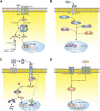Morphogenesis, Growth Cycle and Molecular Regulation of Hair Follicles
- PMID: 35646909
- PMCID: PMC9133560
- DOI: 10.3389/fcell.2022.899095
Morphogenesis, Growth Cycle and Molecular Regulation of Hair Follicles
Abstract
As one of the main appendages of skin, hair follicles play an important role in the process of skin regeneration. Hair follicle is a tiny organ formed by the interaction between epidermis and dermis, which has complex and fine structure and periodic growth characteristics. The hair growth cycle is divided into three continuous stages, growth (anagen), apoptosis-driven regression (catagen) and relative quiescence (telogen). And The Morphogenesis and cycle of hair follicles are regulated by a variety of signal pathways. When the signal molecules in the pathways are abnormal, it will affect the development and cycle of hair follicles, which will lead to hair follicle-related diseases.This article will review the structure, development, cycle and molecular regulation of hair follicles, in order to provide new ideas for solving diseases and forming functional hair follicle.
Keywords: BMP; WNT; hair cycling; hair follicles; morphogenesis.
Copyright © 2022 Lin, Zhu and He.
Conflict of interest statement
The authors declare that the research was conducted in the absence of any commercial or financial relationships that could be construed as a potential conflict of interest.
Figures




References
Publication types
LinkOut - more resources
Full Text Sources
Other Literature Sources
Research Materials

